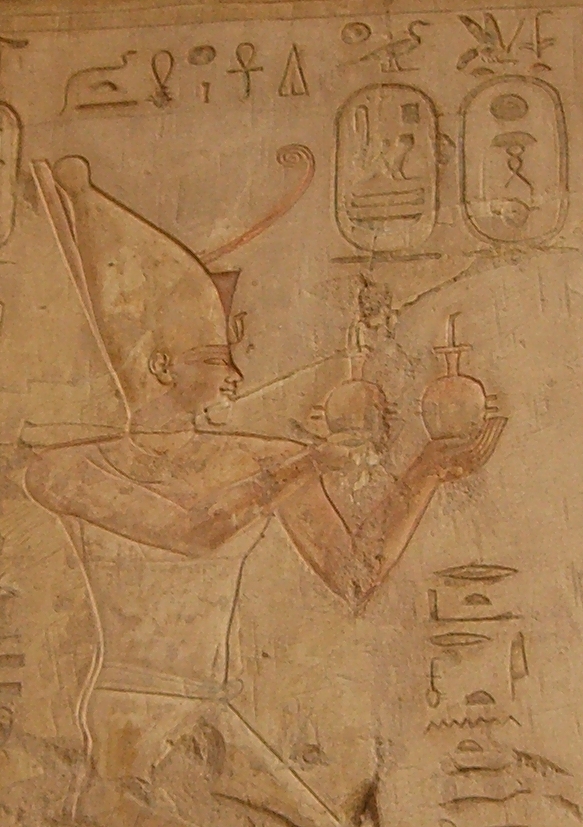- Psamtik I
Pharaoh Infobox | Name=Psamtik I [ [http://www.digitalegypt.ucl.ac.uk/chronology/psametiki.html Psamtek I Wahibre] ] |

Caption=Relief of Psamtik I making an offering to Ra-Horakhty (Tomb of Pabasa)
NomenHiero=p:z-m-T:k
Nomen="Psamtik"
PrenomenHiero=ra-wAH-ib
Prenomen="Wahibre" | Golden="Qenu"
Nebty="Neba"
Horus="Aaib"
HorusHiero=aA:ib*Z1
Reign=664 – 610 BC
Died=610 BC
Predecessor=Necho I
Successor=Necho II
Spouse =Mehtenweskhet [ [http://www.touregypt.net/featurestories/psamtik1.htm Psamtik I] ]
Alt=Psammetichus
Dynasty=26th dynasty
Burial=Sais
Children=Necho II , Nitocris IPsamtik I (also spelled Psammeticus or Psammetichus), was the first of three kings of the Saite, or
Twenty-sixth dynasty of Egypt . His prenomen, Wahibre, means "Constant is the Heart of Re. [Peter Clayton, Chronicle of the Pharaohs, Thames and Hudson, 1994. p.195] The story inHerodotus of theDodecarchy and the rise of Psamtik is fanciful. It is known from cuneiform texts that twenty local princelings were appointed byEsarhaddon and confirmed byAssurbanipal to govern Egypt.Necho I , the father of Psammetichus by his Queen Istemabet, was the chief of these kinglets, but they seem to have been quite unable to hold theEgyptians to the hatedAssyria ns against the more sympatheticNubia ns. Thelabyrinth built byAmenemhat III of theTwelfth dynasty of Egypt is ascribed by Herodotus to the Dodecarchy, or rule of 12, which must represent this combination of rulers. Psamtik was the son of Necho I who died in 664 BC when the Kushite king Tantamani tried unsuccesfully to seize control of lower Egypt from the Assyrian Empire. After his father's death, Psamtik managed to both unite all of Egypt and free her from Assyrian control within the first ten years of his reign.Military campaigns
Psamtik I reunified Egypt in his 9th regnal year when he dispatched a powerful naval fleet in March 656 BC to Thebes and compelled the existing
God's Wife of Amun at Thebes to adopt his daughter Nitocris I as her Heiress in the so-calledAdoption Stela . Psamtik's success destroyed the last vestiges of the Nubian Dynasty's control over Upper Egypt underTantamani since Thebes now accepted his authority. Nitocris would serve in office for 70 years from 656 BC until her death in 586 BC. Thereafter, Psamtik I campaigned vigorously against those local princes who opposed his reunification of Egypt. One of his victories over certain Libyan marauders is mentioned in a Year 10 and Year 11 stela from theDakhla Oasis . Psamtik I proved to be a great Pharaoh of Egypt who won Egypt's independence from the Assyrian Empire and restored Egypt's prosperity through his long 54 Year reign. The pharaoh proceeded to establish intimate relations with the Greeks and also encouraged many Greek settlers to establish colonies in Egypt and serve in the Egyptian army.Discovering the origin of language
The Greek historian
Herodotus conveyed an anecdote about Psamtik in the second volume of his "Histories". During his travel to Egypt, Herodotus heard that Psammetichus ("Psamtik") sought to discover the origin of language by conducting an experiment with two children. Allegedly he gave two newborn babies to a shepherd, with the instructions that no one should speak to them, but that the shepherd should feed and care for them while listening to determine their first words. The hypothesis was that the first word would be uttered in the root language of all people. When one of the children cried "bekos" with outstretched arms the shepherd concluded that the word wasPhrygian because that was the sound of Phrygian word for "bread." Thus, they concluded that the Phrygians were an older people than the Egyptians, and that Phrygian was the original language of men. There are no other extant sources to verify this story.Wives
Psamtik I's chief wife was
Mehtenweskhet , the daughter of Harsiese, theVizier of the North and High Priests ofAtum at Heliopolis. Psamtik and Mehtenweshket were the parents ofNecho II , Merneith, and the Divine Adoratice Nitocris I.Psamtik's father-in-law--the aforementioned Harsiese--was married three times: to Sheta, with whom he had a daughter named Naneferheres, to Tanini and, finally, to an unknown lady, by whom he had both Djedkare, the
Vizier of the South andMehtenweskhet . [Nos ancêtres de l'Antiquité, 1991,Christian Settipani , p.153, 160 & 161] Harsiese was the son ofVizier Harkhebi, and was related to two other Harsieses, bothViziers , who were a part of the family of the famous Mayor of ThebesMontuemhat .References
Wikimedia Foundation. 2010.
